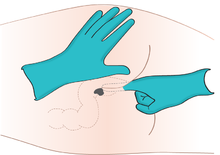
Back إعطاء معوي Arabic Enteral German Nutrición enteral Spanish Voie entérale French Enteralna primjena Croatian Enteralna ishrana Serbo-Croatian Enteralna ishrana Serbian



Enteral administration is food or drug administration via the human gastrointestinal tract. This contrasts with parenteral nutrition or drug administration (Greek para, "besides" + enteros), which occurs from routes outside the GI tract, such as intravenous routes. Enteral administration involves the esophagus, stomach, and small and large intestines (i.e., the gastrointestinal tract). Methods of administration include oral, sublingual (dissolving the drug under the tongue), and rectal. Parenteral administration is via a peripheral or central vein.[1] In pharmacology, the route of drug administration is important because it affects drug metabolism, drug clearance, and thus dosage. The term is from Greek enteros 'intestine'.
- ^ "Enteral administration - pharmacology". britannica.com. Retrieved 19 April 2018.
© MMXXIII Rich X Search. We shall prevail. All rights reserved. Rich X Search